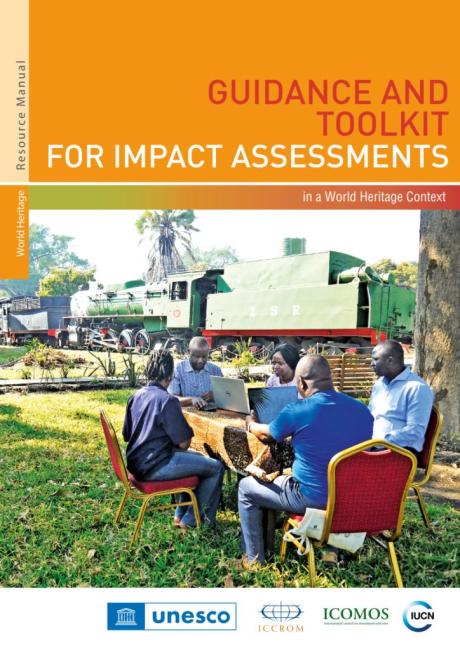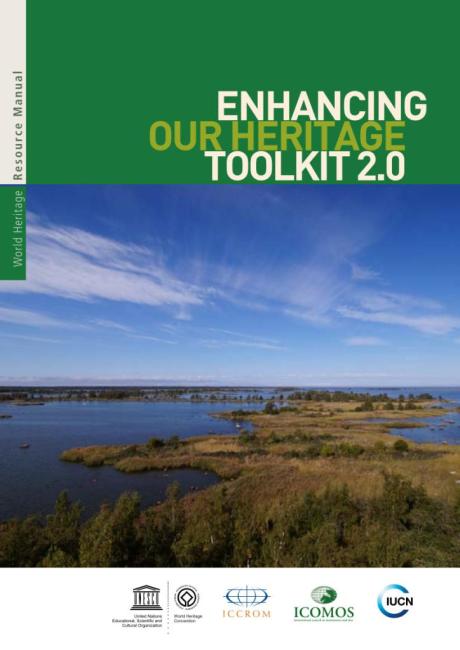Decision-making processes
- Decision-making processes should be analysed to see if they are equitable, respectful of rights, participatory and transparent.
- Decision-making for World Heritage All inherited assets which people value for reasons beyond mere utility. Heritage is a broad concept and includes shared legacies from the natural environment, the creations of humans and the creations and interactions between humans and nature. It encompasses built, terrestrial, freshwater and marine environments, landscapes and seascapes, biodiversity, geodiversity, collections, cultural practices, knowledge, living experiences, etc. takes place at multiple levels, and the various decision-making roles and responsibilities should be clearly defined to lead to more effective and collaborative management linked with accountability.
- Decisions and recommendations by the World Heritage All inherited assets which people value for reasons beyond mere utility. Heritage is a broad concept and includes shared legacies from the natural environment, the creations of humans and the creations and interactions between humans and nature. It encompasses built, terrestrial, freshwater and marine environments, landscapes and seascapes, biodiversity, geodiversity, collections, cultural practices, knowledge, living experiences, etc. Committee must be considered and responded to.
- Rights-holders Actors socially endowed with legal or customary rights with respect to heritage resources. In cases where there are Indigenous people involved, they have the right to free, prior and informed consent before approval of any project affecting their lands or territories and other resources, and need to participate in impact assessment. must be involved in decision-making and treated differently to stakeholders who have an interest but no rights over the heritage place.
- Conflict can arise in the management of heritage places, particularly where there are unequal power dynamics, and effectively resolving these conflicts should be carried out in accordance with principles of good governance and may benefit from mediation.
Analysing governance arrangements involves not only looking at who is involved but also how decisions are made. This needs both an assessment of the quality of decision-making processes in the light of good governance principles, as well as questioning formal and informal decision-making processes. Analysing if those processes are equitable, respectful of rights, participatory, and transparent is critical. Decision-making processes can occur at different levels – including local, regional, national and sometimes international – and hence involve many different actors.
To make sound decisions, it is important that all actors involved have access to adequate information and that they are fully aware of how decisions enable or constrain the management of the heritage place, as well as their rights and responsibilities. Transparent and participatory decision-making processes will need time and the investment of resources but they usually prove cost-effective in the long run, as they harness the contributions of diverse actors, promote collaboration and prevent conflicts.
Governance arrangements vary considerably from one heritage place to another and so do the decision-making processes associated with them. Due to the international recognition of World Heritage, decision-making takes place at multiple levels. However, in many heritage places, this aspect of management is often not given the consideration it deserves and as a result, roles and decision-making responsibilities of each manager are not clearly defined, leading to overlaps, gaps or contradictions about who should do what. Taking the time to understand decision-making at a heritage place will lead to more effective management.
The type of heritage place can determine the complexity of the decision-making processes. Some heritage places may mainly come under the responsibility of a single manager, with other administrative levels having an oversight role and acting only when particular challenges arise. In other cases, decision-making processes among multiple managers working at different levels and in different sectors, should complement each other. This is particularly important for urban and landscape properties, and also for serial, transboundary and transitional properties. The management of heritage places requires the participation of rights-holders, local communities and other associated communities, which adds other layers of decision-making.
Interactions for decision-making occur through collaboration and exchange between multiple actors both formal (e.g. through legal procedures) and informal (e.g. based on relationships and trust): for instance, when a municipal planning department coordinates with a heritage authority over the potential construction of a new road near an archaeological site, or when a port authority consults the heritage authority about shipping operations close to a sensitive marine sanctuary.
In cases where there are serious concerns about the protection of a
World Heritage property
A cultural, natural or mixed heritage place inscribed on the World Heritage List and therefore considered to be of OUV for humanity. The responsibility for nominating a property to the World Heritage List falls upon the State(s) Party(ies) where it is located. The World Heritage Committee decides whether a property should be inscribed on the World Heritage List, taking into account the technical recommendations of the Advisory Bodies following rigorous evaluation processes.
When used as a general term, World Heritage refers to all the natural, cultural and mixed properties inscribed on the World Heritage List.
, the World Heritage Committee can make recommendations about it to the State Party. Such interactions between the international and national levels require appropriate hierarchical procedures to ensure the transmission of information across the relevant institutions at different administrative levels (i.e. national, regional and/or local). Often, those institutions will also need to collaborate and combine their powers and resources to implement the Committee’s recommendations. Levels of decentralization within a country will help determine if decisions will be implemented centrally or locally, and which will have more of an oversight role.
Decision-making processes may stipulate that the manager with primary heritage responsibilities is only legally required to inform other managers about certain actions or decisions taken. In other cases, that manager may be legally required to consult with other managers before taking certain decisions. Sometimes, different managers are legally bound to decide on issues together, for instance when developing and jointly implementing a management plan. In some cases of community-based management, it may be necessary for the community to take a majority vote or reach consensus before certain decisions are made.
Other aspects can influence the reality of decision-making, such as when managers have limited power or capacity to take decisions because of legal constraints, lack of financial resources or lack of political support. This can be especially the case when a rights-holder group is recognized as the de facto manager but without legal clarity about that role or the powers and instruments that go with it to implement its responsibilities. For example, a religious body may be de facto in charge of an architectural ensemble; however, that body may not have the authority to undertake certain conservation works without the authorization of a government institution.
The creation of heritage institutions in the past century has led to governments taking most responsibility for the protection and management of heritage places in many countries. This has sometimes undermined customary practices by Indigenous Peoples and local communities that contributed to the conservation of the heritage place. If those practices (or similar ones) are assured by the heritage authorities, the conservation outcomes remain largely the same. However, if the heritage authorities cannot undertake certain interventions because they have to spread the use of their resources across an increasing number of heritage places or resources, then sooner or later problems will arise.
The interplay of formal and customary governance arrangements must therefore be carefully examined and supported by co-management agreements, which describe the roles, responsibilities and contributions of the different actors. It is important to note that rights-holders must be involved in decision-making and treated differently to stakeholders who have an interest but no rights over the heritage place.
A first step towards effective decision-making processes involves clarifying the roles and responsibilities of each manager within the heritage place’s management system. Managers may be bound by their legal mandate which can go beyond the management of a single heritage place. The manager may not have a mandate that is specific to heritage, for example, in the case of municipalities which are responsible for a historic town centre or a cultural landscape, and in these cases, they may have a much larger jurisdiction than the heritage place. As such, a good understanding of the role that each manager plays within the management system of a heritage place, and how they contribute to decision-making processes, is crucial for that system to function effectively.
When decision-making is the responsibility of more than one manager, mechanisms are needed to facilitate coordination by:
- Establishing collaborative platforms to bring managers together on a regular basis.
- Setting-up protocols for exchanging information.
- Defining clear rules and procedures for making decisions, for example through memorandums of understanding.
- Determining who has the lead in coordinating and harmonizing efforts.
- Specifying mechanisms to reach collaborative decisions and measures to address disputes.
In practice, for collaboration to happen, managers have to believe that working together will generate better outcomes and provide benefits that would not occur in unilateral or less inclusive decision-making processes. As a result, this increases the managers’ willingness to seek agreement and find compromises when needed.
Conflict can arise in the management of heritage places, for instance, due to the different views held on what should be prioritized, the approaches to be adopted, or in determining the most effective measures to respond to factors affecting the place. Issues of access to the heritage place and its resources can also be subject to competing cultural and economic interests, and the allocation of limited resources can be a source of contention. Unequal power dynamics among the various actors involved in the management of the heritage place can lead to disputes, as certain individuals or groups may wield more authority, power and influence over decision-making processes.
Recognizing and effectively resolving these conflicts, in accordance with the principles of good governance presented in this manual (see 4.1), is a challenging responsibility shouldered by managers of heritage places. In some cases, seeking the assistance of mediators may be necessary to facilitate productive
dialogue and reach mutually agreeable solutions, such as neutral facilitators or consultants. In addition, certain general approaches can help managers navigate the complexities and tensions that arise in conflict resolution in heritage places:
- Building relationships between actors is the most overlooked yet essential element of resolving conflict and creating new collaborative ways of working. This requires a significant investment of time, goodwill and other resources.
- Transparency, through continuous, timely, and understandable information-sharing, is crucial to foster trust and understanding among all actors. Open and honest communication can help bridge gaps in understanding and foster collaborative approaches to conflict resolution.
- Resourcing for consultative processes, including at the time of management planning and resource allocation, is essential, ensuring that sufficient time, funding, and expertise are allocated to effectively engage all relevant actors in meaningful discussions and decision-making.
- In difficult situations, implementing effective dispute resolution processes is vital. This involves establishing mutually agreed mechanisms for consensus-building in advance, continuous dialogue, mediation, negotiation, and arbitration, providing a structured framework for addressing conflicts and reaching consensus.
- Emphasizing the importance of inclusivity in decision-making processes is essential. Rights-holders Actors socially endowed with legal or customary rights with respect to heritage resources. In cases where there are Indigenous people involved, they have the right to free, prior and informed consent before approval of any project affecting their lands or territories and other resources, and need to participate in impact assessment. should have the opportunity to contribute their perspectives and have their voices considered in the decision-making process.
- Is there a platform or mechanism to bring managers together at regular intervals to discuss management issues and facilitate decision-making? If not, is one needed? If yes, is it working well and are necessary resources identified and allocated?
- Are there clear, common and agreed upon management objectives for the property or other heritage place? Have all managers committed to implement the agreed objectives?
- Are there formal agreements between managers to facilitate the exchange of information about the management of the property and any existing buffer zone(s)? If no such agreements exist, are there broader agreements that could be used as a basis to facilitate cooperative management?
- Are there informal agreements or collaborative exchange arrangements between managers? If necessary, how might such informal practices be reinforced and expanded to include other managers?
- Is information shared among all managers or only between some of them?
- Are there obligations to share certain types of information among managers? If not, is information shared in informal ways?
- How is information compiled and archived? How is information made available to all managers?
- Are there clear rules and procedures as to how the management plan for the property and any existing buffer zone(s) are to be integrated into and/or align with all other planning instruments?
- When different managers develop policies and plans that will affect the management of the property, are other managers consulted about their content? Is it a requirement to at least consult with the manager with the primary responsibility for the
World Heritage property
A cultural, natural or mixed heritage place inscribed on the World Heritage List and therefore considered to be of OUV for humanity. The responsibility for nominating a property to the World Heritage List falls upon the State(s) Party(ies) where it is located. The World Heritage Committee decides whether a property should be inscribed on the World Heritage List, taking into account the technical recommendations of the Advisory Bodies following rigorous evaluation processes.
When used as a general term, World Heritage refers to all the natural, cultural and mixed properties inscribed on the World Heritage List. , from a heritage perspective? - If working with a serial property involving different jurisdictions and multiple managers, are there procedures to coordinate and harmonize decision-making processes across the different components?
- Is there a clear understanding of the areas where the roles and interests of different managers are aligned and where there may be potential conflict?
- Is the practice of some customary rights in conflict with the management objectives for the property? Do rights-holder practices positively contribute to the protection and management of the property?
- UNESCO, ICCROM, ICOMOS, IUCN (2023). Tool 4 Governance Arrangements and Tool 8 Decision making processes in Enhancing Our Heritage All inherited assets which people value for reasons beyond mere utility. Heritage is a broad concept and includes shared legacies from the natural environment, the creations of humans and the creations and interactions between humans and nature. It encompasses built, terrestrial, freshwater and marine environments, landscapes and seascapes, biodiversity, geodiversity, collections, cultural practices, knowledge, living experiences, etc. Toolkit 2.0. Paris, UNESCO.



